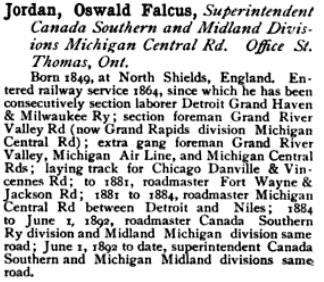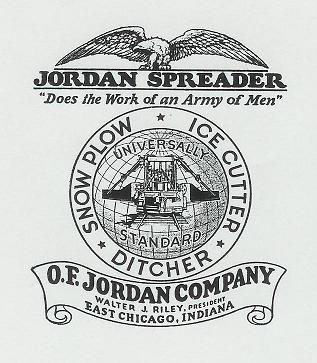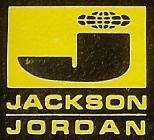The Jordan Spreader
A Remarkable Invention
The Jordan Spreader as we know it, was invented by Oswald Falcus Jordan born in 1849. Jordan (often misspelled Jorden or Jordon) immigrated to Canada as a boy from his home in North Shields in England.
The article below, from “The Biographical Directory of the Railway Officials of America - 1893”; outlines Jordan's career very well through his life. Jordan started to build his railway spreaders circa 1890. His first patent was issued on May 10, 1891, issued to himself and Robert Potts.
In 1898 Jordan resigned from his position at Canada Southern to focus his complete attention on the Spreader business, which he proceeded to set up in Chicago, Illinois. Jordan ran the business from this location, supervising the construction of his cars at various railroad shops or car builders, five of which were built in 1905 by the Hicks Car Works in Chicago Heights, Illinois.
In 1910, Jordan purchased from the New York Central Railroad a piece of land located in East Chicago, Indiana; in which to construct his own shop.
Jordan passed away on August 1, 1910, and his spreader business was left to his wife and children. The family decided to keep the business, and had their associate: Walter J, Riley (a predominant banker); run the company. He organized the business as a company in 1914 (after it being a sole proprietorship).
"Colonel Riley", as he was known, ran the spreader company as well as his bank, until he retired in 1960. In 1964, Jordan's heirs sold the company to Jackson Vibrators, to form Jackson-Jordan. While Oswald Jordan's main focus was Spreaders, he also patented a multitude of other products, which can be seen on the Patents page.
It should also be noted that he did not as so much invent the railroad spreader car, but perfected the design, and this design has been the only design that was mass produced for over 80 years. More on that below.

Design Changes
When Jordan first started his company, the original spreaders were very simple, built on wood chassis, with only straight wings. The wings were braced by large steel channels, that had to be manually adjusted. This model evolved considerably to his well known, "Knuckle Braced" series with new folding locking arms, a movable front plow, and all steel construction.
The next line of spreaders to come about was the "Standard" series. The Standard line was the next step up from the Knuckle Braced. These featured central pneumatic controls mounted on a riveted chassis. This Standard model line of spreader had options, including different nose blades ranging from small ballast blades to full sized snowplows capable of 16 foot drifts of snow. The Standard model was in production from the early 1920's until the late 1950's. The Standard series evolved during in its production career from a riveted chassis to an all welded steel chassis and central controls, to an all raised and enclosed cab.
The next model of Spreader design to follow, was the "Type A", which was introduced approximately around 1923. The Type A was a longer than the Standard series, and marketed as a heavy duty model. These spreaders were also all pneumatically controlled. The Type A had a larger, beefier style diagonal brace, wing construction, and a larger nose plow. Several other options were offered as well.
Following the Type A, the next model series of spreaders was introduced in 1955, and this being the "Type J" model. The Type J was a revolutionary spreader as it was the first model to be offered with all hydraulic controls, thus making the spreader self sufficient in terms of powering the wings and lighting. The Type J also featured the new front cab. This cab moved all of the controls to the front of the machine, thus giving much more visibility. The Type J could also be optioned out with various standard Jordan options, i.e.: blade heights and type of wings.
The final type of Jordan Spreader design is the "Road Master". Early on, this spreader was essentially an upgraded Standard model with a central cab. Later models were equipped with the front cab. A rear raised deck and new machinery was also added on. These spreaders were in production until the late 1960's. It is apparent that Jordan marked the different styles as "small", "medium" and "large" type of spreader being that build dates from some styles are all in the same era.
Jordan also offered major rebuild programs for older spreaders. These would be massive overhauls which upgraded the older spreaders with new parts and machinery. For instance, the original Knuckle Braced spreaders could be upgraded with the new diagonal braces and locks as those used on the Standard Line of spreaders. This also held for the Type A spreaders, with many being rebuilt with new Front Cabs and new machinery. Jordan also offered rebuilds of Type A spreaders, into hydraulic Type J models.
Please see the main section list where you can see pages on each of the above models and there advancements over the years.
Changes in the Company
With over 1,400 Spreaders produced, Jordan has had a long history. In 1960, The O. F. Jordan Company was purchased by Jackson Vibrators, of Ludington, Michigan; forming the Jackson-Jordan Company. In 1990, Jackson-Jordan was acquired by Pandrol International, and along with the acquisition of Speno Rail Services, formed the Pandrol - Jackson Company.
In 1999, Pandrol - Jackson was absorbed into Harsco Track Technologies. Harsco still offers parts and service for the Jordan Spreaders, and will build a new spreader upon order.
Times Change
Although the production of Jordan's Spreaders were never actually discontinued, construction of new machines fell out of favor for a time due to the fact that so many of them were produced.
In 2001, the Alaska Railroad ordered a brand new Type J model, built to the Alaska Railroad's upgraded specifications for snow service.
Continuing to this day, and in testimony to its many applications including but not limited to snow duties and ditching duties, Jordan Spreaders are used every year, all year round, on just about every railroad in North America.
Other Achievements & Products
Jordan also produced other snowfighting products for railroads, such as a wedge snowplow which was very similar to the one offered by the Russell Car & Snowplow Company.
Comparing the similarities between the Russell and Jordan designs, it is very likely that Jordan procured Russell's patents when the Russell Company folded. Jordan would also build wedge plows for the Illinois Central Railroad constructed upon a flatcar chassis.
Unfortunately, only a handful of Jordan wedge plows were built. A double ended snowplow was attempted but apparently was not successful to merit regular production.
Jordan also constructed several other types of railway maintenance of way equipment, such as a "Track Oiler" in the 1930's, and a Ballast Cleaner, which the Atchison Topeka & Santa Fe purchased.
You can read more about these miscellaneous pieces of equipment on the Other Products chapter.
O. F. Jordan: Other Products
During slow periods of business, O. F. Jordan would operate a car rebuild center, and a tank car cleaning facility in East Chicago, IL. If anybody has information they would like to contribute for these two ventures, you are invited to submit such at JordanSpreader@gmail.com
Logos
Below is example of the two designs of logos used, the original O. F. Jordan and the later Jackson - Jordan logo.
At left is the early Jordan logo, applied to many machines cabs and wings when built, also appearing in most advertisements. The logo on the right, is the Jackson - Jordan logo, was used on primarily on Type J spreaders.
 |
 |
Do you have additional information, graphics, images that you would like to contribute, or corrections and/or questions regarding this page?
Then please feel free to contact me at
JordanSpreader@gmail.com